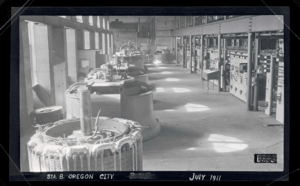T. W. Sullivan Hydroelectric Plant facts for kids

Aerial View
|
|
| Status | Active |
|---|---|
| Construction began | 1888 |
| Opening date | June 3, 1889 |
| Owner(s) | Portland General Electric |
| Operator(s) | Portland General Electric |
Quick facts for kids Dam and spillways |
|
| Spillways | 2 |
| Power station | |
| Name | Station B (T. W. Sullivan) |
| Coordinates | 45°21′05″N 122°37′11″W / 45.3514202°N 122.6196738°W |
| Website www.portlandgeneral.com |
|
The T. W. Sullivan Hydroelectric Plant is a special kind of dam that makes electricity from water. It's owned by Portland General Electric (PGE) and is located at the Willamette Falls. This amazing plant was built a long time ago, between 1888 and 1895.
This plant made history! It was the first place in the United States to send electricity over a long distance. When it first opened in 1889, it was called Station A. Later, in 1895, a new part called Station B was built, and Station A was removed. In 1953, Station B was renamed after Thomas Sullivan, the engineer who designed it. Today, the plant still produces a lot of electricity, between 11,000 and 17,500 kilowatts. The Sullivan Plant is also special because it's one of only a few "Green" hydroelectric plants in the country. A part of a paper mill was even built on top of the dam in the 1920s, and it's still working!
How the Plant Was Built
The oldest part of this dam is the Willamette Falls Locks, which were built in 1873. The rest of the dam was built later to support Station A, the first power station.
Early Power Generators
The first generators used in Station B were huge machines made by Westinghouse. At the time, they were the biggest alternators ever built. Westinghouse even thought they might not last more than 10 years! But PGE is very proud that these same alternators are still working today, though they have more modern covers.
Upgrades and Changes
In 1911, more Westinghouse alternators were added. A giant Allis-Chalmers generator, three times bigger than the first ones, was also installed. However, a big flood in 1924 damaged half of the water turbines. This meant they had to remove half of the generators, including the largest one. Then, in 1953, two of the generators were replaced with smaller ones.
Images for kids







